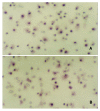Inhibitory effects of c9, t11-conjugated linoleic acid on invasion of human gastric carcinoma cell line SGC-7901
- PMID: 12970874
- PMCID: PMC4656642
- DOI: 10.3748/wjg.v9.i9.1909
Inhibitory effects of c9, t11-conjugated linoleic acid on invasion of human gastric carcinoma cell line SGC-7901
Abstract
Aim: To investigate the effect of c9, t11-conjugated linoleic acid (c9, t11-CLA) on the invasion of human gastric carcinoma cell line and its possible mechanism of preventing metastasis.
Methods: Using reconstituted basement membrane invasion, chemotaxis, adhesion, PAGE substrate zymography and RT-PCR assays, we analyzed the abilities of invasion, direct migration, adhesion of intracellular matrix, as well as the activity of type IV collagenase and expression of tissue inhibitor of metalloproteinase (TIMP)-1 and TIMP-2 mRNA in SGC-7901 cells which were treated with gradually increased concentrations (25, 50, 100 and 200 micromol/L) of c9, t11-CLA for 24 h.
Results: At the concentrations of 200 micromol/L, 100 micromol/L and 50 micromol/L, c9,t11-CLA suppressed the invasion of SGC-7901 cells into the reconstituted basement membrane by 53.7 %, 40.9 % and 29.3 %, respectively, in comparison with the negative control. Only in the 200 micromol/L c9,t11-CLA group, the chemotaxis of SGC-7901 cells was inhibited by 16.0 % in comparison with the negative control. C9,t11-CLA also could inhibit the adhesion of SGC-7901 cells to laminin, fibronectin and Matrigel, increase the expression of TIMP-1 and TIMP-2 mRNA, and reduce type IV collagenase activities in the serum-free medium supernatant of SGC-7901 cells.
Conclusion: c9,t11-CLA can inhibit the invasion of SGC-7901 cells at multiple procedures in tumor metastasis cascade, which may be associated with the induction of TIMP-1 and TIMP-2 mRNA expression.
Figures







Similar articles
-
[Effects of c9, t11-conjugated linoleic acid on the metastasis of human gastric carcinoma cell line].Wei Sheng Yan Jiu. 2003 Mar;32(2):117-9. Wei Sheng Yan Jiu. 2003. PMID: 12792999 Chinese.
-
[The effects of conjugated linoleic acid on the expression of invasiveness and metastasis-associated gene of human gastric carcinoma cell line].Zhonghua Yu Fang Yi Xue Za Zhi. 2003 Jan;37(1):26-8. Zhonghua Yu Fang Yi Xue Za Zhi. 2003. PMID: 12760791 Chinese.
-
[Study on inhibitory effects of c9, t11-conjugated linoleic acid on migration of human gastric carcinoma cell line via cyclooxygenase-2 pathway].Zhonghua Yu Fang Yi Xue Za Zhi. 2007 Nov;41(6):471-4. Zhonghua Yu Fang Yi Xue Za Zhi. 2007. PMID: 18399127 Chinese.
-
Effect of apoptosis on gastric adenocarcinoma cell line SGC-7901 induced by cis-9, trans-11-conjugated linoleic acid.World J Gastroenterol. 2002 Dec;8(6):999-1004. doi: 10.3748/wjg.v8.i6.999. World J Gastroenterol. 2002. PMID: 12439913 Free PMC article.
-
The anticarcinogenic conjugated fatty acid c9, t11-c18:2, or rumenic acid, in human milk: amounts and effects.Adv Exp Med Biol. 2001;501:153-6. doi: 10.1007/978-1-4615-1371-1_19. Adv Exp Med Biol. 2001. PMID: 11787677 Review.
Cited by
-
Conversion of t11t13 CLA into c9t11 CLA in Caco-2 cells and inhibition by sterculic oil.PLoS One. 2012;7(3):e32824. doi: 10.1371/journal.pone.0032824. Epub 2012 Mar 12. PLoS One. 2012. PMID: 22427892 Free PMC article.
-
Linoleic acid enhances angiogenesis through suppression of angiostatin induced by plasminogen activator inhibitor 1.Br J Cancer. 2011 Nov 22;105(11):1750-8. doi: 10.1038/bjc.2011.434. Epub 2011 Oct 20. Br J Cancer. 2011. PMID: 22015554 Free PMC article.
-
Linoleic Acid Modulates the Expression of Metastatic and Angiogenic Markers MMP-2 and Talin-2 in Gastric Cancer Cell Line MKN-45.Iran J Public Health. 2024 Jul;53(7):1612-1620. doi: 10.18502/ijph.v53i7.16055. Iran J Public Health. 2024. PMID: 39086406 Free PMC article.
-
Tissue-dependent effects of cis-9,trans-11- and trans-10,cis-12-CLA isomers on glucose and lipid metabolism in adult male mice.J Nutr Biochem. 2019 May;67:90-100. doi: 10.1016/j.jnutbio.2019.01.020. Epub 2019 Feb 10. J Nutr Biochem. 2019. PMID: 30856468 Free PMC article.
-
Effects of bile reflux and intragastric microflora changes on lesions of remnant gastric mucosa after gastric operation.World J Gastroenterol. 2004 May 15;10(10):1537-9. doi: 10.3748/wjg.v10.i10.1537. World J Gastroenterol. 2004. PMID: 15133869 Free PMC article.
References
-
- Sébédio JL, Gnaedig S, Chardigny JM. Recent advances in conjugated linoleic acid research. Curr Opin Clin Nutr Metab Care. 1999;2:499–506. - PubMed
-
- Pariza MW, Park Y, Cook ME. Mechanisms of action of conjugated linoleic acid: evidence and speculation. Proc Soc Exp Biol Med. 2000;223:8–13. - PubMed
-
- Pariza MW, Park Y, Cook ME. Conjugated linoleic acid and the control of cancer and obesity. Toxicol Sci. 1999;52:107–110. - PubMed
-
- Whigham LD, Cook ME, Atkinson RL. Conjugated linoleic acid: implications for human health. Pharmacol Res. 2000;42:503–510. - PubMed
-
- MacDonald HB. Conjugated linoleic acid and disease prevention: a review of current knowledge. J Am Coll Nutr. 2000;19:111S–118S. - PubMed
Publication types
MeSH terms
Substances
LinkOut - more resources
Full Text Sources
Medical
Research Materials
Miscellaneous

